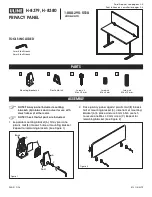
15
GB
HECTOR 1700/2300W - REV003A
USAGE - WARNING
WARNING:
stay clear of the chains, ropes and gypsy. Make sure the electric motor is off when windlass is used manually
(even when using the handle to disengage the clutch). In fact people with windlass remote controls (hand-held remote
control or radio-controlled systems) might accidentally operate it.
WARNING:
secure the chain with a device before starting the navigation.
WARNING:
do not operate the windlass by using the electrical power when the handle is inserted in the drum or into the
gypsy cover.
WARNING:
Quick
®
recommend using a circuit breaker designed for direct current (DC) with delayed-action (thermal-mag-
netic or hydraulic-magnetic) to protect the motor supply line from overheating or short circuits. The circuit breaker can be
used to cut off power to the windlass control circuit and so avoid accidental activation.
CLUTCH USE
The clutch (26 and 28) provides a link between the gypsy (27) and the main shaft (4 or 5). The clutch can be released (disengage-
ment) by using the handle (35) which, when inserted in the bush (31) of the gypsy cover (29), must be turned counter-clockwise.
The clutch will be re-engaged by turning it clockwise (engagement).
WEIGHING THE ANCHOR
Turn on the engine. Make sure the clutch is engaged and remove the handle. Press the UP button on
the control provided. If the windlass stops and the hydraulic magnetic switch (or thermal cutout) has not tripped, wait a few sec-
onds and try again (avoid keeping the button pressed). If the hydraulic magnetic switch, has tripped, reset it and wait a few min-
utes before weighing anchor once again. If, after a number of attempts, the windlass is still blocked, we suggest to move the boat
to release the anchor. Check the upward movement of the chain for the last few meters in order to avoid damages to the bow.
CASTING THE ANCHOR
The anchor can be cast by using the electrical control or manually. To operate manually, the clutch
must be disengaged allowing the gypsy to revolve and letting the rope or chain fall into the water. To slow down the chain, the
handle must be turned clockwise. To cast the anchor by using the electrical power, press the DOWN button on the control pro-
vided. In this manner, anchor casting is under control and the chain and rope unwind evenly. In order to avoid any stress on the
windlass -once the boat is anchored- fasten the chain or secure it in place with a rope.
DRUM USE
WARNING:
Before carrying out warping operations, check that the anchor and relative rope or chain are solidly fi xed to a
bitt or another strong point on the boat.
For the independent use of the drum (32) release the clutch with the handle (35), (at least 2 turns of the bush anticlockwise).
Remove the handle (35) from the bush on the gypsy cover (29), wrap the rope around the drum (at least 3 turns). Activate the
windlass control (17), keeping the rope under tension during take up. By varying the tension during take up it is possible to
modify the rope winding speed.
WARNING:
during take up maintain a safe distance between hands and windlass drum.
Once take up is complete, screw up the clutch by tightening the gypsy cover’s bush (31) clockwise and secure the rope to a bitt
or other strong point on the boat.
MANUAL ANCHOR WEIGHING (Except for versions with drum on gypsy)
Secure the chain with a clamp, disconnect
the windlass power supply.
WARNING:
Before weighing anchor
release the gypsy. Check that the
lock control (17) on the gypsy is dis-
engaged.
To lock the gypsy insert the handle (35)
into the gypsy lock handle control (20)
Turn the handle 90° anticlockwise until
the lock control (17) slots into the groove
on the gypsy.
17
20
35
RELEASED GYPSY
LOCKED GYPSY
90°
Содержание HC 1712 2B
Страница 2: ......
Страница 45: ...NOTE NOTES NOTES NOTIZEN NOTAS ...
Страница 46: ...NOTE NOTES NOTES NOTIZEN NOTAS ...
Страница 47: ......
















































